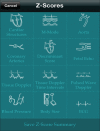The use of Z-scores in paediatric cardiology
- PMID: 23129909
- PMCID: PMC3487208
- DOI: 10.4103/0974-2069.99622
The use of Z-scores in paediatric cardiology
Abstract
Z-scores are a means of expressing the deviation of a given measurement from the size or age specific population mean. By taking account of growth or age, Z-scores are an excellent means of charting serial measurements in paediatric cardiological practice. They can be applied to echocardiographic measurements, blood pressure and patient growth, and thus may assist in clinical decision-making.
Keywords: Blood pressure; Z-score; cardio Z; echocardiography; paediatric cardiology.
Conflict of interest statement
Figures



References
-
- Huxley JS, Teissier G. Terminology of Relative Growth. Nature. 1936;137:780–1.
-
- McMahon T. Size and shape in biology. Science. 1973;179:1201–4. - PubMed
-
- Sluysmans T, Colan SD. Theoretical and empirical derivation of cardiovascular allometric relationships in children. J Appl Physiol. 2005;99:445–57. - PubMed
-
- Lopez L, Colan SD, Frommelt PC, Ensing GJ, Kendall K, Younoszai AK, et al. Recommendations for quantification methods during the performance of a pediatric echocardiogram: A report from the Pediatric Measurements Writing Group of the American Society of Echocardiography Pediatric and Congenital Heart Disease Council. J Am Soc Echocardiogr. 2010;23:465–95. quiz 576-7. - PubMed
LinkOut - more resources
Full Text Sources
Other Literature Sources

